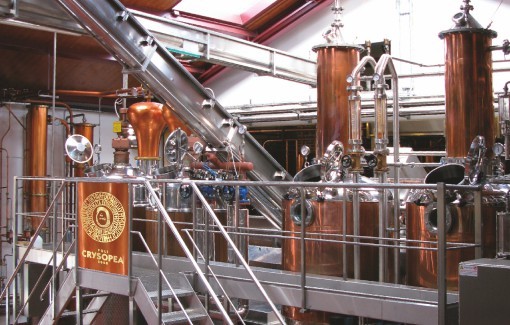Distillery
Crysopea is reborn
Crysopea the new, but also very ancient, double boiler vacuum still is reborn at Poli Distillerie
Crysopea, the most innovative double boiler vacuum still, is reborn at Poli Distillerie in Schiavon (Veneto).
Thanks to Poli Distillerie, the study of a double boiler vacuum still, started in 2003 by the Experimental Centre of the San Michele all'Adige Agricultural Institute, has now borne its fruit.
After five years of experimentation from 2005 to 2010, the new Crysopea now flanks the historic steam pot still owned by the Poli family, thus expanding the distillation methods used for generations and creating grappa with distinct and unique sensory characteristics.
Crysopea represents a significant contribution in the development of Grappa production technology with the discontinuous artisan method, standing out from traditional systems for two characteristics: vacuum operation and the adjustable reflux enrichment column without plates.
More specifically, Crysopea consists of:
an in-line water/steam heat exchanger; a heating and evaporation double boiler equipped with adjustable speed stirrer and slide valve on the bottom for the discharge of depleted matter; an adjustable reflux enrichment column without plates, placed directly over the boiler and cooled by a flow of water; a condensation and cooling assembly, consisting of a condensing coil column recirculating water in countercurrent and a freezer containing a first distillate collection tank (vacuum and cooled); a final distillate collection tank (normally in vacuum, at atmospheric pressure in the discharge phase); a liquid ring vacuum pump.
The system is discontinuous: the volatile compounds flow directly into the distillation and enrichment column where they undergo fractionating as they rise. The result is a process of fractioned distillation and dephelgmation adjustable in intensity by varying the flow of cooling water circulating in the jacket of the column.
The vapours then enter the condensation and cooling assembly, whereas the distillate is collected in a tank inside the freezer. What enters this tank still in the vapour phase is sucked by the pump (vacuum) and discharged together with the pump cooling water.
This is an important technological-production milestone achieved by Poli Distillerie: in fact , the use of vacuum in the distillation process had been attempted over the years by various professionals, and above all by the Italian Enrico Componi, but it was only after many decades that it was used in production and not just experimentally, given the considerable technical difficulties associated with the risk of implosion of the still and condensation of the vapours.
The main advantage of distillation carried out by means of Crysopea is the lowering of the boiling point of alcohol and the various volatile compounds present in the grape marc, determined by the negative pressure, i.e. the vacuum, inside the still. This offers a distillate characterised by delicate floral and fruity fragrances which, in being thermolabile, are normally lost due to the temperatures inside a boiler.
In fact, the distillates obtained with Crysopea are significantly improved due to:
- an increase in the terpene floral note
- a big reduction in head impurities
- a significant reduction in esters
- a reduction in methyl alcohol
The name Chrysopoeia is written in history: it was Cleopatra, an alchemist of Ancient Egypt, who created the first ever pot still in which to distil gold, the most precious of metals, calling it Chrysopoeia, from the Greek Chrysos, "gold", and "poieo, "to make". The Poli family's decision to distil golden muscat marc with the new still is a tribute to the alchemist Cleopatra and his "quest for gold".
In this regard, Jacopo Poli, who has followed the creation of Crysopea since the first studies in 2003, states with satisfaction that "the new Crysopea closes a symbolic circle begun by the alchemist Cleopatra thousands of years ago. Hence a complete cycle whose importance is marked by the inclusion of the dragon Uroboros biting its own tail, on the label of the new Cleopatra Moscato Oro. In fact, this is the name of the first distillate which we will put on the market, coming from this new but very ancient still."

